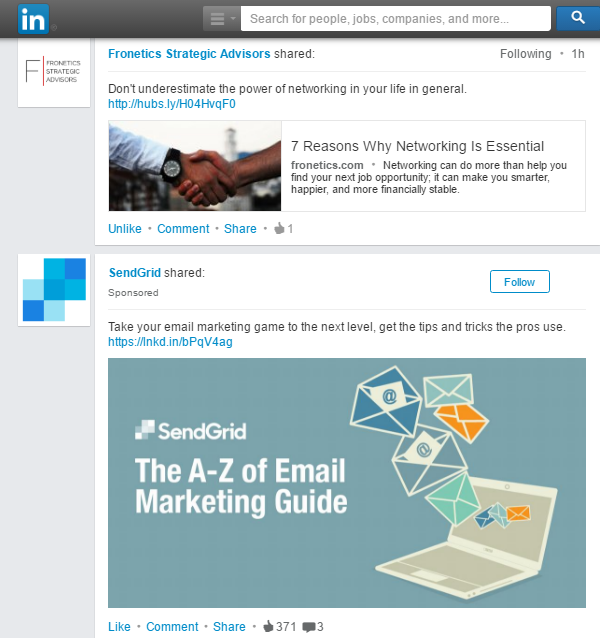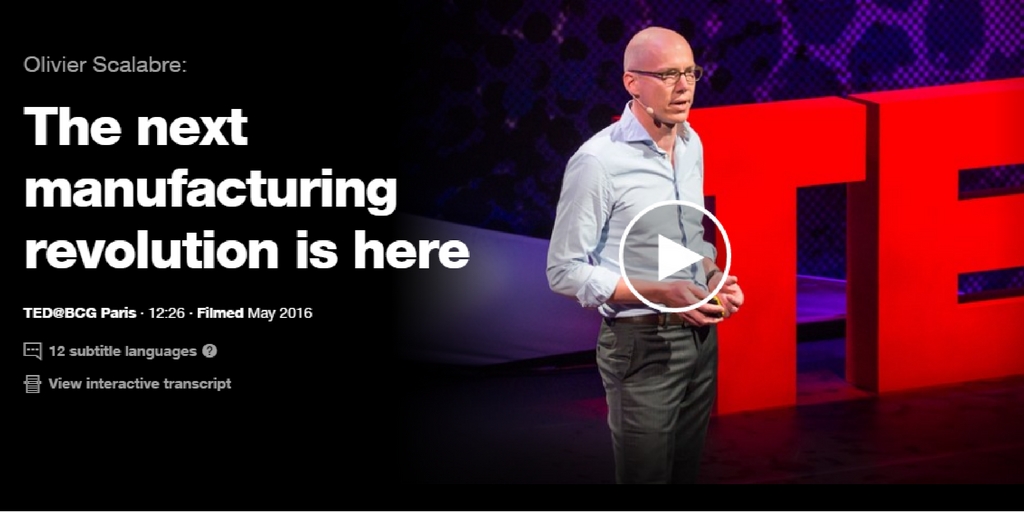
by Fronetics | Oct 19, 2016 | Blog, Content Marketing, Marketing, Social Media, Supply Chain
Native advertising is the non-ad-like way to promote your business’ content to users who might be interested in it.
Is your business using native advertising to promote your content with a targeted audience? If not, you’re missing out on one of the biggest upcoming trends in content marketing.
So how can your business use this technique to promote your content and, ultimately, your products and services? Let’s take a look at the basics of native advertising.
What is native advertising?
Native advertising blurs the line between advertising and editorial content. It allows publishers (of content) to get their message to a targeted audience in a format the audience is already using. Think of sponsored updates on LinkedIn, which look just like regular posts, or when a radio DJ promotes a product within the regular broadcast.
Content Marketing Institute founder Joe Pulizzi defines native advertising with the following three qualities:
- “A Directly Paid Opportunity. I hate to bring out the obvious, but native advertising is ‘pay to play.’ If a brand or individual did not pay for the spot, it’s not native advertising.
- “Usually Content Based. The information is useful, interesting and highly targeted to the specific readership. So, in all likelihood, it’s not an advertisement promoting the company’s product or service directly.
- “Delivered In-Stream. To truly be a native ad, the user experience is not disrupted. The advertising is delivered in a way that does not impede the normal behavior of the user in that particular channel.”
Native advertising is not content marketing…
… But it can be an effective way to promote your content.
Remember, content may be king, but distribution is queen, and she wears the pants. That is to say: Publishing valuable and relevant content in a strategic and consistent manner will create demand for your products and services. But content doesn’t go far — actually it goes nowhere — without distribution.
Native advertising is a paid opportunity to distribute your content to more people. It can be more effective than non-native advertising, like banner ads or commercials, because it does not interrupt the user experience but rather complements it. It doesn’t feel like an ad, even though someone paid to have it appear on your screen.
Social media platforms are offering more and more opportunities for businesses to advertise this way through sponsored posts and updates. LinkedIn, Facebook, Instagram, Pinterest — you may have noticed that more and more posts from companies you don’t follow appear in your newsfeeds now. These platforms use proprietary algorithms to help businesses target users might be interested in the content they are promoting.
Here’s what a sponsored post on LinkedIn looks like, for example:

The sponsored post from SendGrid looks just like the other posts in my feed. Another important thing: It’s totally relevant for the kind of content I consume. I might even ignore the comma splice and click on it to get the information about email marketing because that’s what I like to read about on LinkedIn.
Some native advertising facts
The use of native advertising is growing among businesses because it is proving to be so effective. Here are some facts that might interest you.
Doing it right
Because native advertising blurs the line between editorial and advertising, some advertisers have gotten in trouble for violating rules of compliance. In response, the FTC has come out with some official guidelines for native ads in order to prevent confusion and to protect consumers. If your business is launching a native advertising campaign, make sure that you are familiar with these rules and best practices.
Related posts:

by Fronetics | Oct 18, 2016 | Blog, Logistics, Manufacturing & Distribution, Strategy, Supply Chain
These TED Talks, which cover issues from technology to business strategy, will be of interest to companies in the supply chain.
Back in December, we wrote about 5 TED Talks that might be of interest to the supply chain. Since that time, the popularity of the site has continued to grow, and it continues to add more interesting and thought-provoking content.
Here are 5 more TED Talks from 2016 that companies in the supply chain and logistics industry will want to see. They cover a range of topics, from technology to business strategy.
TED Talks the supply chain will want to watch
1. The Next Manufacturing Revolution Is Here
By Oliver Scalabre, Senior Partner and Managing Director, BCG – Paris
Economic growth has been slowing for the past 50 years, but relief might come from an unexpected place — a new form of manufacturing that is neither what you thought it was nor where you thought it was. Industrial systems thinker Olivier Scalabre details how a fourth manufacturing revolution will produce a macroeconomic shift and boost employment, productivity, and growth. Watch
2. The Jobs We’ll Lose to Machines — and the Ones We Won’t
By Anthony Goldbloom, Co-Founder and CEO of Kaggle
Machine learning isn’t just for simple tasks like assessing credit risk and sorting mail anymore — today, it’s capable of far more complex applications, like grading essays and diagnosing diseases. With these advances comes an uneasy question: Will a robot do your job in the future? Watch
3. Two Reasons Companies Fail — and How to Avoid Them
By Knut Haanaes, Professor of Strategy and International Management, IMD
Is it possible to run a company and reinvent it at the same time? For business strategist Knut Haanaes, the ability to innovate after becoming successful is the mark of a great organization. He shares insights on how to strike a balance between perfecting what we already know and exploring totally new ideas — and lays out how to avoid two major strategy traps. Watch
4. How to Build a Business that Lasts 100 Years
By Martin Reeves, Director of the BCG Henderson Institute
If you want to build a business that lasts, there may be no better place to look for inspiration than your own immune system. Join strategist Martin Reeves as he shares startling statistics about shrinking corporate life spans and explains how executives can apply six principles from living organisms to build resilient businesses that flourish in the face of change. Watch
5. Shape-Shifting Tech Will Change Work as We Know It
By Sean Follmer, Assistant Professor of Mechanical Engineering, Stanford University
What will the world look like when we move beyond the keyboard and mouse? Interaction designer Sean Follmer is building a future with machines that bring information to life under your fingers as you work with it. In this talk, check out prototypes for a 3D shape-shifting table, a phone that turns into a wristband, a deformable game controller and more that may change the way we live and work. Watch
Related posts:

by Fronetics | Oct 17, 2016 | Blog, Content Marketing, Logistics, Marketing, Social Media, Strategy, Supply Chain
Learn the basics of pay-per-click advertising — what it means and which platforms you can use — in this quick training.
Pay-per-click advertising can be an effective complement to a content marketing campaign for companies in the supply chain and logistics industries. Essentially, you can get your business’ name and content in front of people who are searching online for products and services like yours — but you’ll only pay for those who click on your advertisement. Sounds great, right?
But here’s where things get a little complicated: Should you use Google AdWords or Google Display Network? What’s the difference? What about Facebook and Twitter advertising? Is a Sponsored Post on LinkedIn considered pay-per-click?
We at Fronetics have developed a basic training on pay-per-click advertising for supply chain and logistics organizations. Learn more about what it can do for your business, as well as which platforms are available and the differences between them.
This training offers information about:
- Google AdWords
- Google Display Network
- Facebook Ads
- Instagram Ads (photo, video, carousel)
- Twitter Advertising (Promoted Tweets, Promoted Twitter Accounts, Promoted Trends)
- LinkedIn Advertising (Sponsored Posts, text and image ads)
Click the button below to download our free pay-per-click advertising training.

Related posts:

by Fronetics | Oct 13, 2016 | Blog, Content Marketing, Marketing, Social Media
Here’s a summary of what’s been happening on all of your favorite social media platforms lately.
Social media platforms change so frequently, it’s often hard to keep up. But, since social media is a crucial part of any effective content marketing strategy, it’s important to know what tools are available to your business and how you might gain value from using them.
That being said, we’ll be regularly summarizing any updates, changes, additions, or otherwise noteworthy goings-on in the social media world in this space. Feel free to send me an email if you want more information about any of these tools or if you’d like to see us cover something new in social media that we haven’t.
Facebook combats fake stories in Trending Topics
After letting its news curation staff go this summer, Facebook is working to find a solution to combat sensational news stories from creeping into its Trending news section, now run completely by algorithms. The company announced that it will implement a technology similar to that used by the news feed feature. Read more
Longer tweets come to Twitter
As of September 19, Twitter has changed the kind of content that counts toward the 140-character limit in tweets. Media attachments, quote tweets, and @names in replies no longer count toward the limit. Read more
Snapchat becomes Snap Inc., launches video sunglasses
In September, Snapchat launched a new line of business, video-enabled sunglasses (called Spectacles), and rebranded with a new corporate name, Snap Inc. CEO Evan Spiegel said in a blog post that the rebranding reflects the company’s diversification. Read more
Facebook launches Messenger Day to Poland, and it looks a lot like Snapchat
Facebook Messenger users in Poland, where Snapchat is not yet popular, can now share illustrated photos and videos that disappear within 24 hours. The platform says it often tests new features before rolling them out to other markets, but it is not yet clear if or when Messenger Day will come to the U.S. Read more
Twitter rolls out Moments to all members
Moments are a collection of tweets that focus on the same subject. Previously available only to specific partners, all members are now able to use this feature. Read more
Facebook enhances Canvas’ capabilities for brand advertising
New metrics, templates, and upcoming features like 360 videos are all ways Facebook is expanding the advertising feature’s utility for all businesses. Read more. Relatedly, brands can now create custom audiences based on users who have viewed their Canvas ads on Facebook. Read more
Pinterest launches Promote button
Brands can now promote their pins when creating it or when viewing it on their profiles with the new Promote button. Read more
Vimeo rolls out Vimeo Business
Video streaming platform Vimeo officially announced its business-focused membership option, Vimeo Business. The subscription includes unlimited bandwidth, analytics tools, and lead-generation mechanisms. Read more
Related posts:

by Fronetics | Oct 12, 2016 | Blog, Content Marketing, Marketing
Make sure you’re not making these seven common mistakes when starting your B2B blog.
So you’ve started a B2B blog for your business and are standing at the ready, waiting for those leads to start rolling in. But you’ve only gotten three views so far (you, twice, and one by your mother). It’s not working out exactly how you pictured.
For one, it takes time — and patience — to build up readership for any blog. The more content you publish, the greater its quality, and the more consistently you post, the more quickly that success will happen.
But, chances are, you’re making one (or more) of the rookie mistakes that prevent B2B blogs from driving traffic, leads, and sales. Take a look at the seven common blogging errors that are holding you back.
7 common blogging mistakes for new B2B blogs
1) You’re promoting your products, services, and/or business.
Believe it or not, your sales pitch is bad for business. While your blog seems like another avenue for advertising your products, that’s actually counterproductive. Today’s consumers have no tolerance for overt, interruption-based marketing. They can smell a sales pitch from a mile away and purposefully avoid them. There is plenty of content available on the internet that they have the ability to do so.
Here’s another way to think of it: When have you ever changed channels while watching TV to find a commercial? If you’re flipping around, it’s probably because you’re looking for content that is appealing to you, not seeking advertisements. Blog readers feel the same way.
Solution?
Your posts should provide information, value, and/or entertainment relevant to your area of expertise for your target audience. They will read it — and, ideally, subscribe — because they regard you as a trusted source of knowledge. When they are ready to purchase, you will be top of mind because of the rapport you’ve built through your content.
2) You write about anything and everything.
While it’s important to publish content that is meaningful to you and relevant to your area of expertise, your B2B blog shouldn’t be a dumping ground for every thought that crosses your mind. It’s not a forum for you to discuss what seems interesting to you on a given day. Unless you’re a celebrity whose lifestyle is your brand, your blog is not the place to make it about you.
Solution?
On the contrary, your blog is all about your target audience. Your posts should answer their questions, satisfy their needs, or cater to their interests. You should put considerable thought and planning into what you write to ensure it aligns with their expectations. An editorial calendar can help you map out content for your blog and make sure you are evaluating your posts from the 1,000-foot view as well.
3) Your writing stinks.
Writing a blog is different than writing an academic thesis, a business proposal, or a product catalog. If your content is boring, stuffy, error-filled, unintelligible, or otherwise difficult to read, people are going to move onto the billions of other content available on the internet.
Your readers need to understand what you’re saying, and, what’s more, they need to connect with your content. Of course, that’s easier said than done. It’s ok if you’re not a great writer — the first step is admitting that and then deciding what to do about it.
Solution?
Hire someone to write it for you. At the very least, have a colleague glance over your posts for errors and clarity.
4) You’re a copycat.
There are so many good ideas and well-written articles out there that some people might be tempted to copy and paste without fear of retribution. Unfortunately that will only hurt your B2B blog.
Firstly, discerning readers can tell when something’s not quite right. It’s easy for them to find the original source with a quick Google search, and even easier for them to never trust your blog again. Further, search engines can penalize your site if you’re caught plagiarizing content, which can dramatically impact your potential growth.
Solution?
Make sure your blog contains original content and ideas. If you use information or images from another site, make sure to properly cite them.
5) You’re not posting frequently enough.
Blogging frequency impacts factors like search engine rankings and audience engagement. Posting rarely or without any kind of regularity will negatively affect both, and thus your readership.
Solution?
How much is enough? A recent analysis of the top business blogs found that 90.5% blog at least once a week. Figure out the blogging cadence that allows for the most posts with your available resources, and stick to it.
6) You don’t have the option to subscribe (or you’re not pushing it).
A blog is an excellent way to gain organic traffic. But part of your goal should also be to establish a regular readership. After all, you want to build a rapport with potential customers, who come to trust your expertise because they regularly read your content.
Now, people like to do what’s easy. It’s possible that your biggest supporters type in your blog’s web address everyday to see what you’re saying. But it’s more likely that more people will read your content if it arrives in their inboxes on a regular basis.
Solution?
Make sure the option to subscribe to your blog is easy to find and easy to do. Most content management systems make this simple to set up right on your blog. But you can also encourage people to subscribe by adding a call to action to your emails, your social media accounts, etc.
7) You’re not distributing it.
Don’t let your content live in a vacuum. Certainly readers will find your B2B blog through organic search. But you don’t have to just post and pray.
Solution?
Distribute your content through whatever channels you have available to you: social media, email newsletters, paid content-promotion platforms, sites like Reddit and Quora, and more. And don’t just tweet about it once and consider distribution done. Keep distributing it whenever it’s relevant to do so.
Related posts:


by Fronetics | Oct 11, 2016 | Blog, Strategy, Talent
Networking can do more than help you find your next job opportunity; it can make you smarter, happier, and more financially stable.
Kathryn Minshew, founder and CEO of The Muse and The Daily Muse, began a piece for the Harvard Business Blog Network with this sage advice: “Network Your Face Off.” The truth and value of this statement cannot be underestimated.
Here are seven reasons why networking is essential and why connections matter.
1) The larger the network the larger the salary.
A recent study of 6,000 executives in over 3,000 firms found that the more connections an employee has, the greater the salary. Specifically, the study found that a 50% increase in network size accompanies a 3.8% increase in salary with respect to the average.
2) Networks beget jobs.
A survey conducted by The Adler Group found that 46% of active candidates and 49% of passive candidates found employment thanks to networking. Similarly, a study conducted by Banque de France and the University of Toulouse noted that half of all jobs in the United States are filled through personal contacts. ABC News cites an even higher number — according to ABC News, 80% of jobs are landed through networking.
3) Wider networks can lead to better paid jobs.
Research conducted by Federal Reserve Bank of St. Louis economist David Wiczer found that employees who found jobs through individuals within their network got paid, on average, 6% more than employees who found their jobs through direct contact with a firm.
4) Networks provide security.
People who are well-connected are more likely to stay in their jobs longer and have shorter periods of unemployment than people who are not well connected.
5) Networks bring opportunities.
The opportunities networks can bring include: partnerships, invitations to events, introductions, and invitations to give talks and presentations. In short networks bring opportunities that benefit and feed your career, professional development, and personal interests.
6) Networks make you smarter.
Knowing what is happening in your field and industry is vital. When you have a strong network you are more likely to be “in the know” than those who do not have a strong and active network.
7) Networks make you happy.
Minshew writes: “Networks are powerful, and when done right leave you surrounded by a core of individuals who are all rooting for your success and happy to help you.” So true.
Networking is essential. Get out there and build your network.
Related posts:









